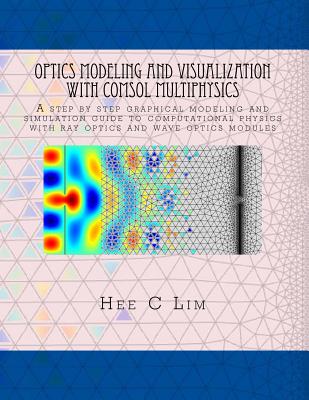Optics Modeling and Visualization with COMSOL Multiphysics: A step by step graphical instruction manuscripts

Optics Modeling and Visualization with COMSOL Multiphysics: A step by step graphical instruction manuscripts
This manuscript is a step-by-step graphical instructions for COMSOL Multiphysics with Ray Optics Module and Wave Optics module modeling and computational physics simulation. All the example models investigated and visualized with the help of Finite Element Analysis are referenced from the standard USA undergraduate text on Optics by E. Hecht. The simulations include the use of geometrical ray tracings for point source, hemispherical, and conic rays as well as full electromagnetic waves source employing the Maxwell's wave equations for Gaussian waves input. Both 2D and 3D computational physics approach will be discussed with the introduction of the trick-of-the-trades meshings, and modeling skill besides setup options that are skillfully hidden in the simulation software from plain sight.The geometrical model covers 2D and 3D electromagnetic waves propagation in user defined refractive index domain; Laws of Refraction for 2D converging and diverging lens; Laws of Reflection for specular mirrors, 3D Prism, 3D Prism mirror equivalent system; Polarizations for 3D linear polarizers, 3D circular polarizer, 3D linear wave retarder such as half wave plate, quarter wave plate; the Theory of Superposition for the 2D Young's double slits Wavefront-splitting interference experiment, 3D thin film uniform thickness Amplitude-splitting interference experiment, 2D Michelson interferometer Mirrored-interference setup with the 1D interference fringes line graph; Fermat's principle for 2D single slits diffraction, 3D circular aperture diffraction experiment, 3D rectangular slit diffraction experiment, 3D diffraction gratings experiment with Fresnel near field and Fraunhofer far field diffraction pattern, diffraction pattern: Sinc() function observation discussions, the Limitation of ray tracing physics vs. full electromagnetic waves simulations in the physics of optics, the Babinet's principle of transparent openings or opaque obstacles diffraction slit; and finally the Modern optics of 2D and 3D LASER cavity multiphysics models with the application of multiple release time of rays for Stimulated Emission lasing. One of the most important and crucial component of the computational physics subject, the user customizable library of material properties that governs the realisticality of the final modeled results, is highlighted in the appendix section.
PRP: 740.20 Lei
Acesta este Pretul Recomandat de Producator. Pretul de vanzare al produsului este afisat mai jos.
666.18Lei
666.18Lei
740.20 LeiLivrare in 2-4 saptamani
Descrierea produsului
This manuscript is a step-by-step graphical instructions for COMSOL Multiphysics with Ray Optics Module and Wave Optics module modeling and computational physics simulation. All the example models investigated and visualized with the help of Finite Element Analysis are referenced from the standard USA undergraduate text on Optics by E. Hecht. The simulations include the use of geometrical ray tracings for point source, hemispherical, and conic rays as well as full electromagnetic waves source employing the Maxwell's wave equations for Gaussian waves input. Both 2D and 3D computational physics approach will be discussed with the introduction of the trick-of-the-trades meshings, and modeling skill besides setup options that are skillfully hidden in the simulation software from plain sight.The geometrical model covers 2D and 3D electromagnetic waves propagation in user defined refractive index domain; Laws of Refraction for 2D converging and diverging lens; Laws of Reflection for specular mirrors, 3D Prism, 3D Prism mirror equivalent system; Polarizations for 3D linear polarizers, 3D circular polarizer, 3D linear wave retarder such as half wave plate, quarter wave plate; the Theory of Superposition for the 2D Young's double slits Wavefront-splitting interference experiment, 3D thin film uniform thickness Amplitude-splitting interference experiment, 2D Michelson interferometer Mirrored-interference setup with the 1D interference fringes line graph; Fermat's principle for 2D single slits diffraction, 3D circular aperture diffraction experiment, 3D rectangular slit diffraction experiment, 3D diffraction gratings experiment with Fresnel near field and Fraunhofer far field diffraction pattern, diffraction pattern: Sinc() function observation discussions, the Limitation of ray tracing physics vs. full electromagnetic waves simulations in the physics of optics, the Babinet's principle of transparent openings or opaque obstacles diffraction slit; and finally the Modern optics of 2D and 3D LASER cavity multiphysics models with the application of multiple release time of rays for Stimulated Emission lasing. One of the most important and crucial component of the computational physics subject, the user customizable library of material properties that governs the realisticality of the final modeled results, is highlighted in the appendix section.
Detaliile produsului









